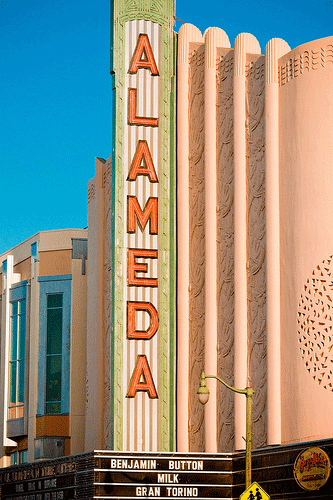
Flickr user Thomas Hawk
Many folks in Alameda aren’t pleased with “Tall is Beautiful,” a story of mine in the May/June issue that chides the liberal Bay Area suburb for rejecting dense, eco-friendly housing. After all, the project was opposed by the mayor, much of the city council, the San Francisco Chronicle, and a bevvy of respectable citizens groups. Now that the story is online, I’m anticipating a barrage of angry comments from Alamedans who think I ignored the downsides of the billion-dollar project to prove my broader point about the advantages of urban density. In reality, debunking every critique of Alameda Point would have made my article as exciting as a court brief. But here on the web, there’s plenty of space to bore you with all the details. Forthwith, a granular takedown of the case against Alameda Point.
The controversy surrounding Alameda Point, a mixed use community planned for an abandoned naval base on the city’s northwest shore, originates with Measure A, a decades-old ballot initiative that banned any housing in Alameda denser than a duplex. Building Alameda Point at its intended density would have required voters to approve an exemption to the law. The easiest way to do that would have been for the city council to draft an exemption and submit it to the ballot. But the city council, knowing that popular Measure A is the “third rail of Alameda politics,” balked at the idea. So Alameda Point’s developer, SunCal, was forced to write up its own ballot initiative and then collect enough signatures to qualify it for the ballot. In February, Measure B, as it’s initiative was known, was overwhelmingly rejected at the polls.
In choosing how to craft the language of Measure B, SunCal faced a dilemma. If the developer kept the ballot initiative short and simple, then voters would worry that the exemption would let it build anything. The alternative, which SunCal SunCal opted for, was to tie the exemption to a long development agreement that described what SunCal would build, what the city would provide, and how the process would be governed. Unfortunately for SunCal, this was clearly a mistake. The lengthy ballot initiative gave opponents the chance to harp on (and sometimes distort) a slew of details. And it was so long and confusing that many voters just gave up on trying to understand it and voted no.
I spent a lot of time pouring over the language of the ballot initiative, and came away believing that it was far from perfect, but also far from the looming apocalypse that its opponents made it out to be. Yes, it included some self-serving legalese written by SunCal’s attorneys. But after this was pointed out, SunCal moved to change the language. Opponents countered that the initiative was written such that it could only be amended at SunCal’s sole discretion after it passed. But the City of Alameda could easily force SunCal to make the changes by closing numerous other legal hoops that the company would have had to jump through before the project got built. I confirmed that point with Alameda’s city attorney.
I’m not the only person who figured this out. Consultants for the Bay Area’s Greenbelt Alliance independently vetted the ballot initiative and arrived at the same conclusion. They also found that foes of the project had used unreasonably pessimistic financial projections; the project was extremely unlikely to place a financial burden on the city. On the contrary, it would help clean up blighted land that was costly to maintain and provide everyone on the island with wonderful parks and services.
What makes the debate over Alameda Point interesting is how one sided it was. People look for what they want to find, and a few vocal Alamedans wanted to find that a mixed-use neighborhood full of dense apartments was a bad deal for the city and its environment. Their arguments prevailed because few interests other than the developer were willing or able to counter them. What Alameda and similar towns need is a new crop of pro-environment, pro-growth community activists. Bring in the YIMBYs!













